Cloud Computing: Models, Misconceptions and Benefits
VerifiedAdded on 2022/11/16
|14
|3620
|446
AI Summary
This technical report explores the different models of cloud computing, including Infrastructure as a Service, Platform as a Service, and Software as a Service. It also discusses misconceptions associated with cloud computing and the benefits it offers, such as increased flexibility and security. The report includes a detailed description of each model and how they are used in commercial establishments. It also clarifies common misconceptions about cloud computing, such as security and cost concerns.
Contribute Materials
Your contribution can guide someone’s learning journey. Share your
documents today.
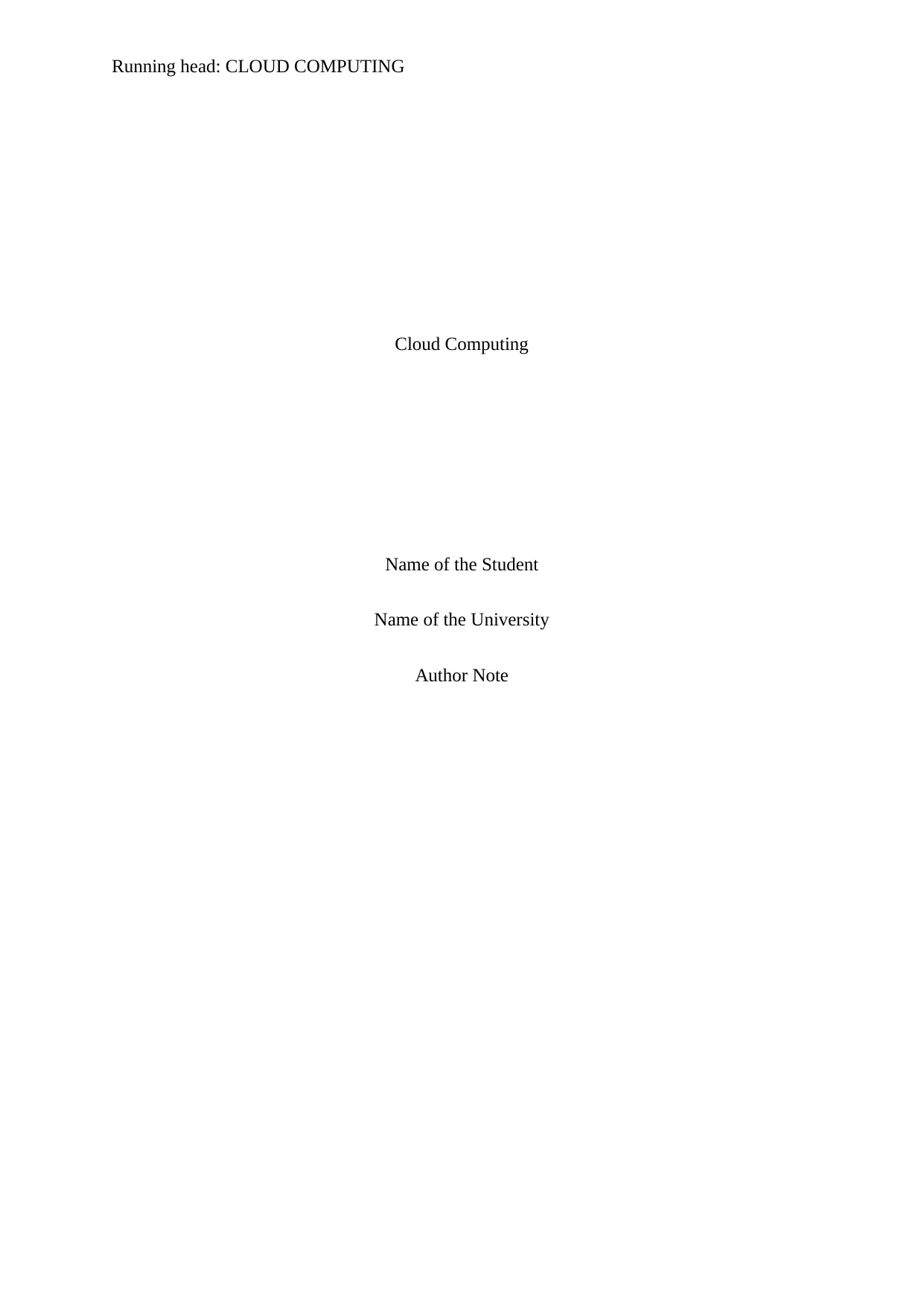
Running head: CLOUD COMPUTING
Cloud Computing
Name of the Student
Name of the University
Author Note
Cloud Computing
Name of the Student
Name of the University
Author Note
Secure Best Marks with AI Grader
Need help grading? Try our AI Grader for instant feedback on your assignments.
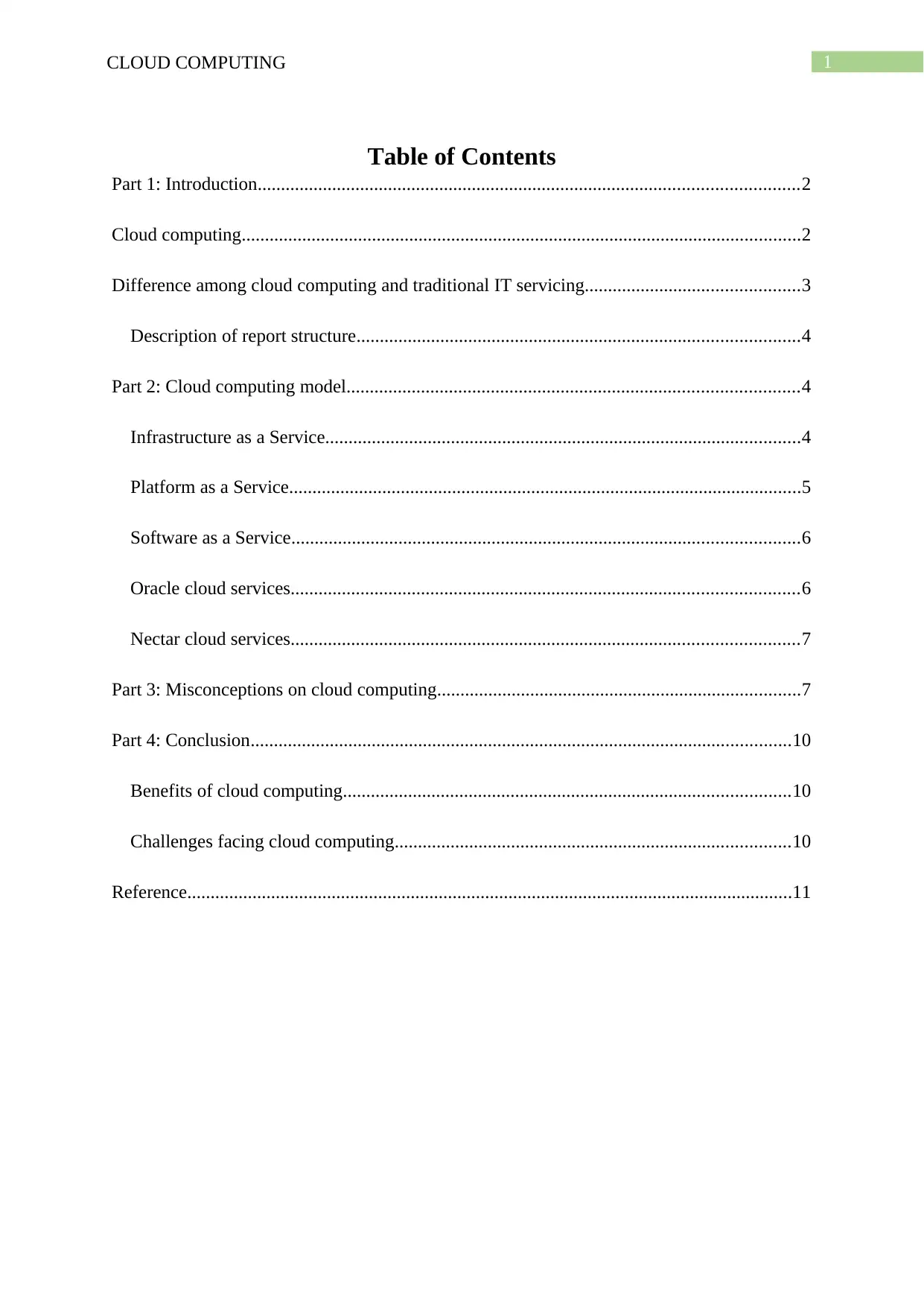
1CLOUD COMPUTING
Table of Contents
Part 1: Introduction....................................................................................................................2
Cloud computing........................................................................................................................2
Difference among cloud computing and traditional IT servicing..............................................3
Description of report structure...............................................................................................4
Part 2: Cloud computing model.................................................................................................4
Infrastructure as a Service......................................................................................................4
Platform as a Service..............................................................................................................5
Software as a Service.............................................................................................................6
Oracle cloud services.............................................................................................................6
Nectar cloud services.............................................................................................................7
Part 3: Misconceptions on cloud computing..............................................................................7
Part 4: Conclusion....................................................................................................................10
Benefits of cloud computing................................................................................................10
Challenges facing cloud computing.....................................................................................10
Reference..................................................................................................................................11
Table of Contents
Part 1: Introduction....................................................................................................................2
Cloud computing........................................................................................................................2
Difference among cloud computing and traditional IT servicing..............................................3
Description of report structure...............................................................................................4
Part 2: Cloud computing model.................................................................................................4
Infrastructure as a Service......................................................................................................4
Platform as a Service..............................................................................................................5
Software as a Service.............................................................................................................6
Oracle cloud services.............................................................................................................6
Nectar cloud services.............................................................................................................7
Part 3: Misconceptions on cloud computing..............................................................................7
Part 4: Conclusion....................................................................................................................10
Benefits of cloud computing................................................................................................10
Challenges facing cloud computing.....................................................................................10
Reference..................................................................................................................................11
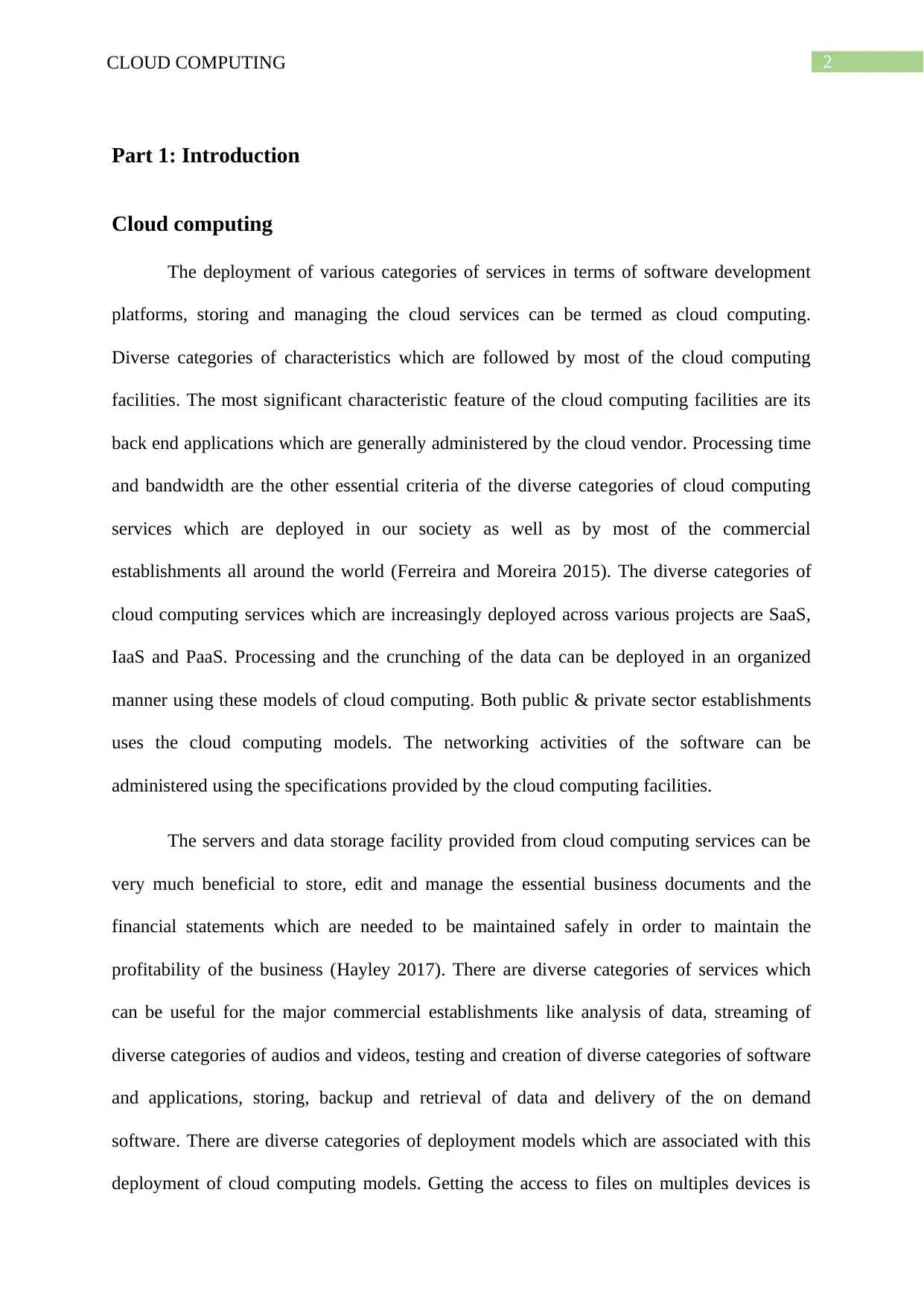
2CLOUD COMPUTING
Part 1: Introduction
Cloud computing
The deployment of various categories of services in terms of software development
platforms, storing and managing the cloud services can be termed as cloud computing.
Diverse categories of characteristics which are followed by most of the cloud computing
facilities. The most significant characteristic feature of the cloud computing facilities are its
back end applications which are generally administered by the cloud vendor. Processing time
and bandwidth are the other essential criteria of the diverse categories of cloud computing
services which are deployed in our society as well as by most of the commercial
establishments all around the world (Ferreira and Moreira 2015). The diverse categories of
cloud computing services which are increasingly deployed across various projects are SaaS,
IaaS and PaaS. Processing and the crunching of the data can be deployed in an organized
manner using these models of cloud computing. Both public & private sector establishments
uses the cloud computing models. The networking activities of the software can be
administered using the specifications provided by the cloud computing facilities.
The servers and data storage facility provided from cloud computing services can be
very much beneficial to store, edit and manage the essential business documents and the
financial statements which are needed to be maintained safely in order to maintain the
profitability of the business (Hayley 2017). There are diverse categories of services which
can be useful for the major commercial establishments like analysis of data, streaming of
diverse categories of audios and videos, testing and creation of diverse categories of software
and applications, storing, backup and retrieval of data and delivery of the on demand
software. There are diverse categories of deployment models which are associated with this
deployment of cloud computing models. Getting the access to files on multiples devices is
Part 1: Introduction
Cloud computing
The deployment of various categories of services in terms of software development
platforms, storing and managing the cloud services can be termed as cloud computing.
Diverse categories of characteristics which are followed by most of the cloud computing
facilities. The most significant characteristic feature of the cloud computing facilities are its
back end applications which are generally administered by the cloud vendor. Processing time
and bandwidth are the other essential criteria of the diverse categories of cloud computing
services which are deployed in our society as well as by most of the commercial
establishments all around the world (Ferreira and Moreira 2015). The diverse categories of
cloud computing services which are increasingly deployed across various projects are SaaS,
IaaS and PaaS. Processing and the crunching of the data can be deployed in an organized
manner using these models of cloud computing. Both public & private sector establishments
uses the cloud computing models. The networking activities of the software can be
administered using the specifications provided by the cloud computing facilities.
The servers and data storage facility provided from cloud computing services can be
very much beneficial to store, edit and manage the essential business documents and the
financial statements which are needed to be maintained safely in order to maintain the
profitability of the business (Hayley 2017). There are diverse categories of services which
can be useful for the major commercial establishments like analysis of data, streaming of
diverse categories of audios and videos, testing and creation of diverse categories of software
and applications, storing, backup and retrieval of data and delivery of the on demand
software. There are diverse categories of deployment models which are associated with this
deployment of cloud computing models. Getting the access to files on multiples devices is
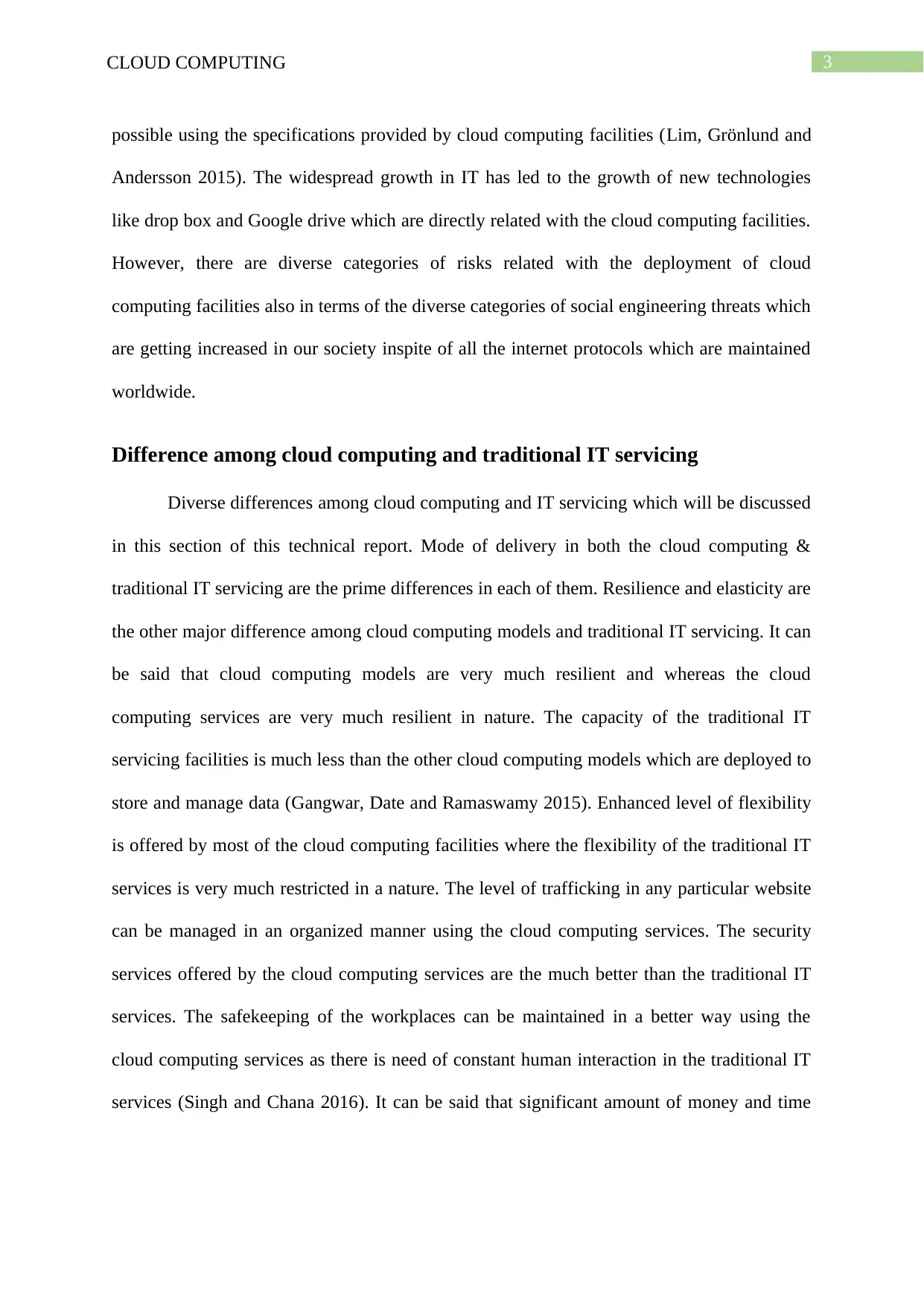
3CLOUD COMPUTING
possible using the specifications provided by cloud computing facilities (Lim, Grönlund and
Andersson 2015). The widespread growth in IT has led to the growth of new technologies
like drop box and Google drive which are directly related with the cloud computing facilities.
However, there are diverse categories of risks related with the deployment of cloud
computing facilities also in terms of the diverse categories of social engineering threats which
are getting increased in our society inspite of all the internet protocols which are maintained
worldwide.
Difference among cloud computing and traditional IT servicing
Diverse differences among cloud computing and IT servicing which will be discussed
in this section of this technical report. Mode of delivery in both the cloud computing &
traditional IT servicing are the prime differences in each of them. Resilience and elasticity are
the other major difference among cloud computing models and traditional IT servicing. It can
be said that cloud computing models are very much resilient and whereas the cloud
computing services are very much resilient in nature. The capacity of the traditional IT
servicing facilities is much less than the other cloud computing models which are deployed to
store and manage data (Gangwar, Date and Ramaswamy 2015). Enhanced level of flexibility
is offered by most of the cloud computing facilities where the flexibility of the traditional IT
services is very much restricted in a nature. The level of trafficking in any particular website
can be managed in an organized manner using the cloud computing services. The security
services offered by the cloud computing services are the much better than the traditional IT
services. The safekeeping of the workplaces can be maintained in a better way using the
cloud computing services as there is need of constant human interaction in the traditional IT
services (Singh and Chana 2016). It can be said that significant amount of money and time
possible using the specifications provided by cloud computing facilities (Lim, Grönlund and
Andersson 2015). The widespread growth in IT has led to the growth of new technologies
like drop box and Google drive which are directly related with the cloud computing facilities.
However, there are diverse categories of risks related with the deployment of cloud
computing facilities also in terms of the diverse categories of social engineering threats which
are getting increased in our society inspite of all the internet protocols which are maintained
worldwide.
Difference among cloud computing and traditional IT servicing
Diverse differences among cloud computing and IT servicing which will be discussed
in this section of this technical report. Mode of delivery in both the cloud computing &
traditional IT servicing are the prime differences in each of them. Resilience and elasticity are
the other major difference among cloud computing models and traditional IT servicing. It can
be said that cloud computing models are very much resilient and whereas the cloud
computing services are very much resilient in nature. The capacity of the traditional IT
servicing facilities is much less than the other cloud computing models which are deployed to
store and manage data (Gangwar, Date and Ramaswamy 2015). Enhanced level of flexibility
is offered by most of the cloud computing facilities where the flexibility of the traditional IT
services is very much restricted in a nature. The level of trafficking in any particular website
can be managed in an organized manner using the cloud computing services. The security
services offered by the cloud computing services are the much better than the traditional IT
services. The safekeeping of the workplaces can be maintained in a better way using the
cloud computing services as there is need of constant human interaction in the traditional IT
services (Singh and Chana 2016). It can be said that significant amount of money and time
Secure Best Marks with AI Grader
Need help grading? Try our AI Grader for instant feedback on your assignments.
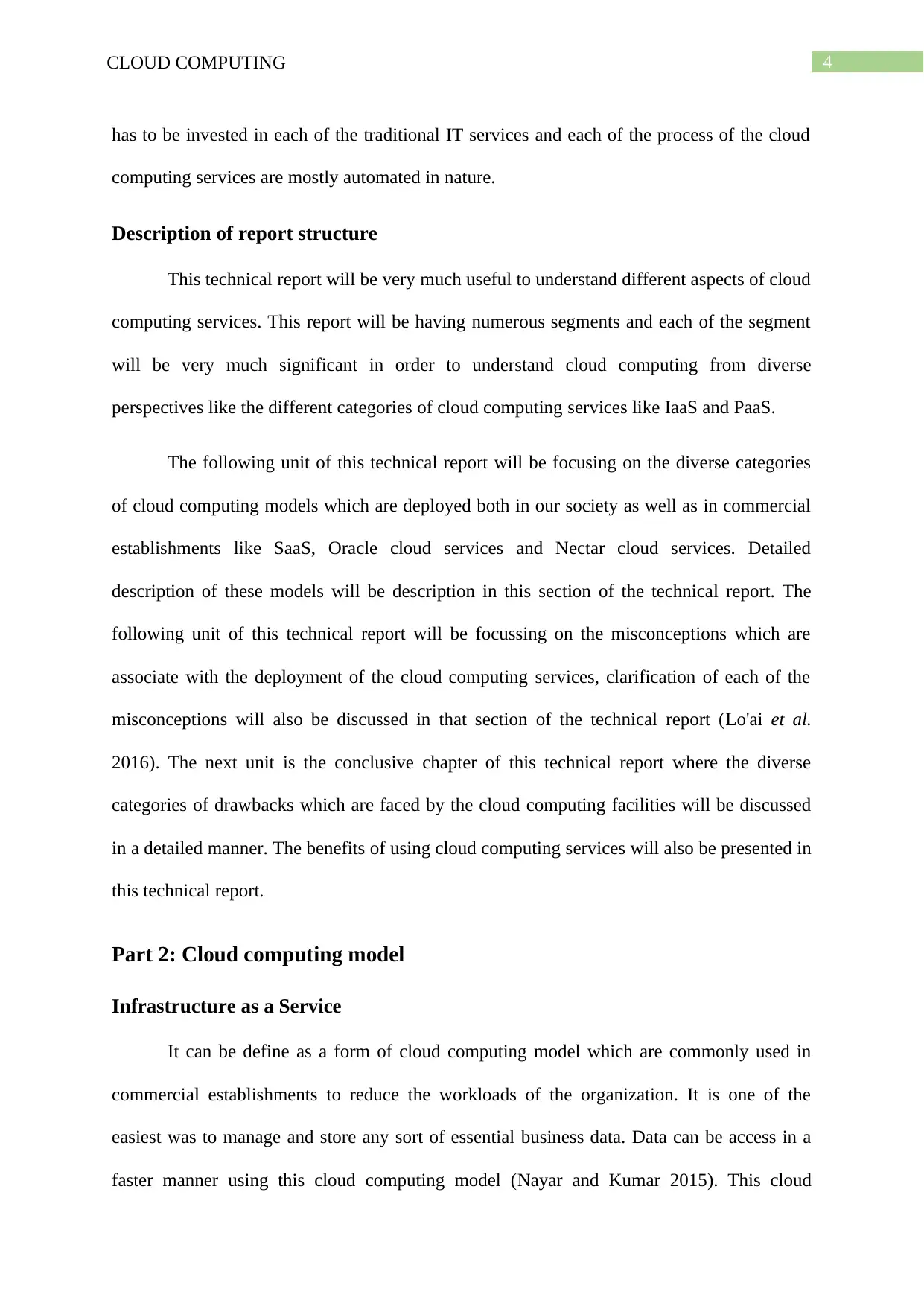
4CLOUD COMPUTING
has to be invested in each of the traditional IT services and each of the process of the cloud
computing services are mostly automated in nature.
Description of report structure
This technical report will be very much useful to understand different aspects of cloud
computing services. This report will be having numerous segments and each of the segment
will be very much significant in order to understand cloud computing from diverse
perspectives like the different categories of cloud computing services like IaaS and PaaS.
The following unit of this technical report will be focusing on the diverse categories
of cloud computing models which are deployed both in our society as well as in commercial
establishments like SaaS, Oracle cloud services and Nectar cloud services. Detailed
description of these models will be description in this section of the technical report. The
following unit of this technical report will be focussing on the misconceptions which are
associate with the deployment of the cloud computing services, clarification of each of the
misconceptions will also be discussed in that section of the technical report (Lo'ai et al.
2016). The next unit is the conclusive chapter of this technical report where the diverse
categories of drawbacks which are faced by the cloud computing facilities will be discussed
in a detailed manner. The benefits of using cloud computing services will also be presented in
this technical report.
Part 2: Cloud computing model
Infrastructure as a Service
It can be define as a form of cloud computing model which are commonly used in
commercial establishments to reduce the workloads of the organization. It is one of the
easiest was to manage and store any sort of essential business data. Data can be access in a
faster manner using this cloud computing model (Nayar and Kumar 2015). This cloud
has to be invested in each of the traditional IT services and each of the process of the cloud
computing services are mostly automated in nature.
Description of report structure
This technical report will be very much useful to understand different aspects of cloud
computing services. This report will be having numerous segments and each of the segment
will be very much significant in order to understand cloud computing from diverse
perspectives like the different categories of cloud computing services like IaaS and PaaS.
The following unit of this technical report will be focusing on the diverse categories
of cloud computing models which are deployed both in our society as well as in commercial
establishments like SaaS, Oracle cloud services and Nectar cloud services. Detailed
description of these models will be description in this section of the technical report. The
following unit of this technical report will be focussing on the misconceptions which are
associate with the deployment of the cloud computing services, clarification of each of the
misconceptions will also be discussed in that section of the technical report (Lo'ai et al.
2016). The next unit is the conclusive chapter of this technical report where the diverse
categories of drawbacks which are faced by the cloud computing facilities will be discussed
in a detailed manner. The benefits of using cloud computing services will also be presented in
this technical report.
Part 2: Cloud computing model
Infrastructure as a Service
It can be define as a form of cloud computing model which are commonly used in
commercial establishments to reduce the workloads of the organization. It is one of the
easiest was to manage and store any sort of essential business data. Data can be access in a
faster manner using this cloud computing model (Nayar and Kumar 2015). This cloud
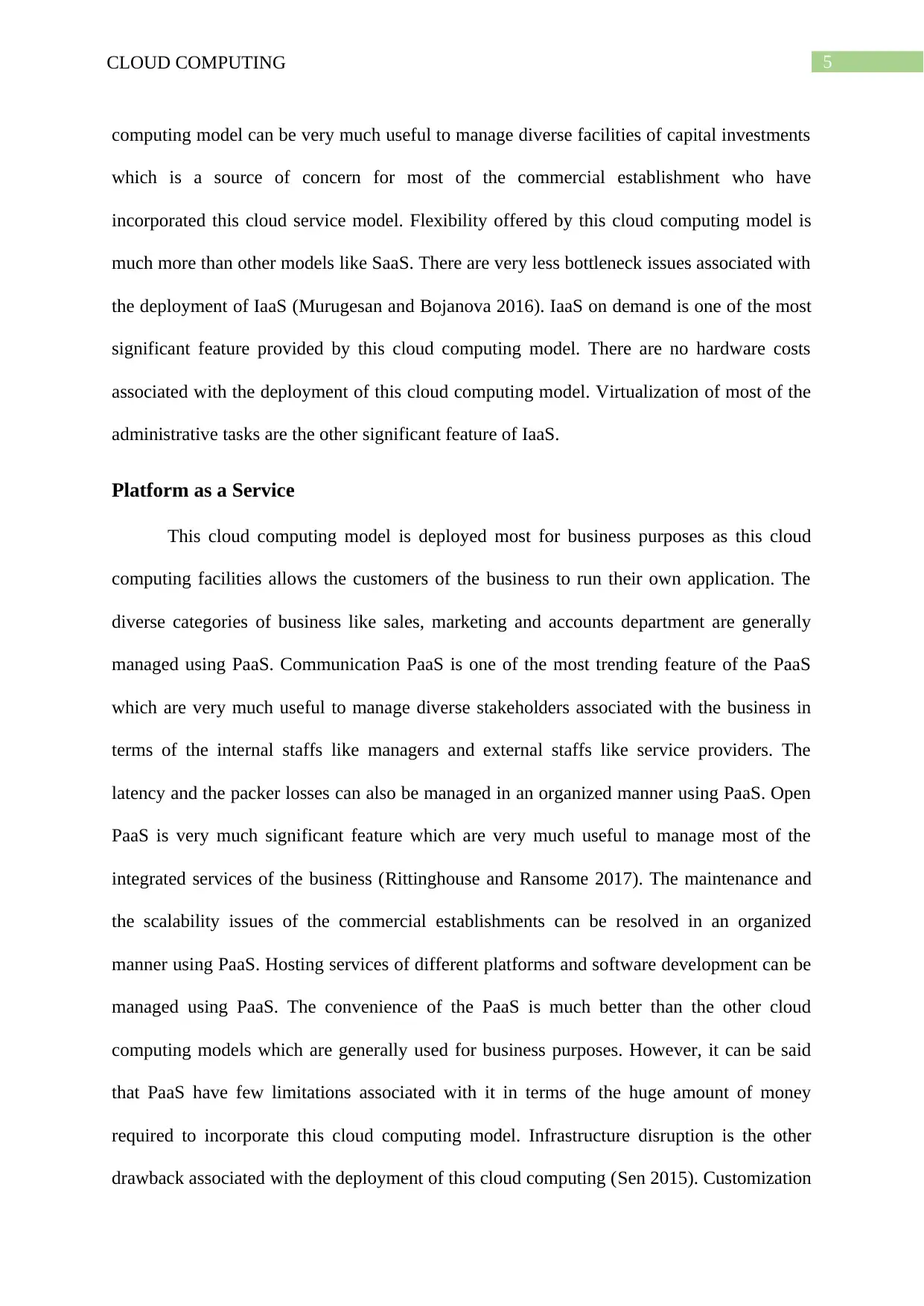
5CLOUD COMPUTING
computing model can be very much useful to manage diverse facilities of capital investments
which is a source of concern for most of the commercial establishment who have
incorporated this cloud service model. Flexibility offered by this cloud computing model is
much more than other models like SaaS. There are very less bottleneck issues associated with
the deployment of IaaS (Murugesan and Bojanova 2016). IaaS on demand is one of the most
significant feature provided by this cloud computing model. There are no hardware costs
associated with the deployment of this cloud computing model. Virtualization of most of the
administrative tasks are the other significant feature of IaaS.
Platform as a Service
This cloud computing model is deployed most for business purposes as this cloud
computing facilities allows the customers of the business to run their own application. The
diverse categories of business like sales, marketing and accounts department are generally
managed using PaaS. Communication PaaS is one of the most trending feature of the PaaS
which are very much useful to manage diverse stakeholders associated with the business in
terms of the internal staffs like managers and external staffs like service providers. The
latency and the packer losses can also be managed in an organized manner using PaaS. Open
PaaS is very much significant feature which are very much useful to manage most of the
integrated services of the business (Rittinghouse and Ransome 2017). The maintenance and
the scalability issues of the commercial establishments can be resolved in an organized
manner using PaaS. Hosting services of different platforms and software development can be
managed using PaaS. The convenience of the PaaS is much better than the other cloud
computing models which are generally used for business purposes. However, it can be said
that PaaS have few limitations associated with it in terms of the huge amount of money
required to incorporate this cloud computing model. Infrastructure disruption is the other
drawback associated with the deployment of this cloud computing (Sen 2015). Customization
computing model can be very much useful to manage diverse facilities of capital investments
which is a source of concern for most of the commercial establishment who have
incorporated this cloud service model. Flexibility offered by this cloud computing model is
much more than other models like SaaS. There are very less bottleneck issues associated with
the deployment of IaaS (Murugesan and Bojanova 2016). IaaS on demand is one of the most
significant feature provided by this cloud computing model. There are no hardware costs
associated with the deployment of this cloud computing model. Virtualization of most of the
administrative tasks are the other significant feature of IaaS.
Platform as a Service
This cloud computing model is deployed most for business purposes as this cloud
computing facilities allows the customers of the business to run their own application. The
diverse categories of business like sales, marketing and accounts department are generally
managed using PaaS. Communication PaaS is one of the most trending feature of the PaaS
which are very much useful to manage diverse stakeholders associated with the business in
terms of the internal staffs like managers and external staffs like service providers. The
latency and the packer losses can also be managed in an organized manner using PaaS. Open
PaaS is very much significant feature which are very much useful to manage most of the
integrated services of the business (Rittinghouse and Ransome 2017). The maintenance and
the scalability issues of the commercial establishments can be resolved in an organized
manner using PaaS. Hosting services of different platforms and software development can be
managed using PaaS. The convenience of the PaaS is much better than the other cloud
computing models which are generally used for business purposes. However, it can be said
that PaaS have few limitations associated with it in terms of the huge amount of money
required to incorporate this cloud computing model. Infrastructure disruption is the other
drawback associated with the deployment of this cloud computing (Sen 2015). Customization
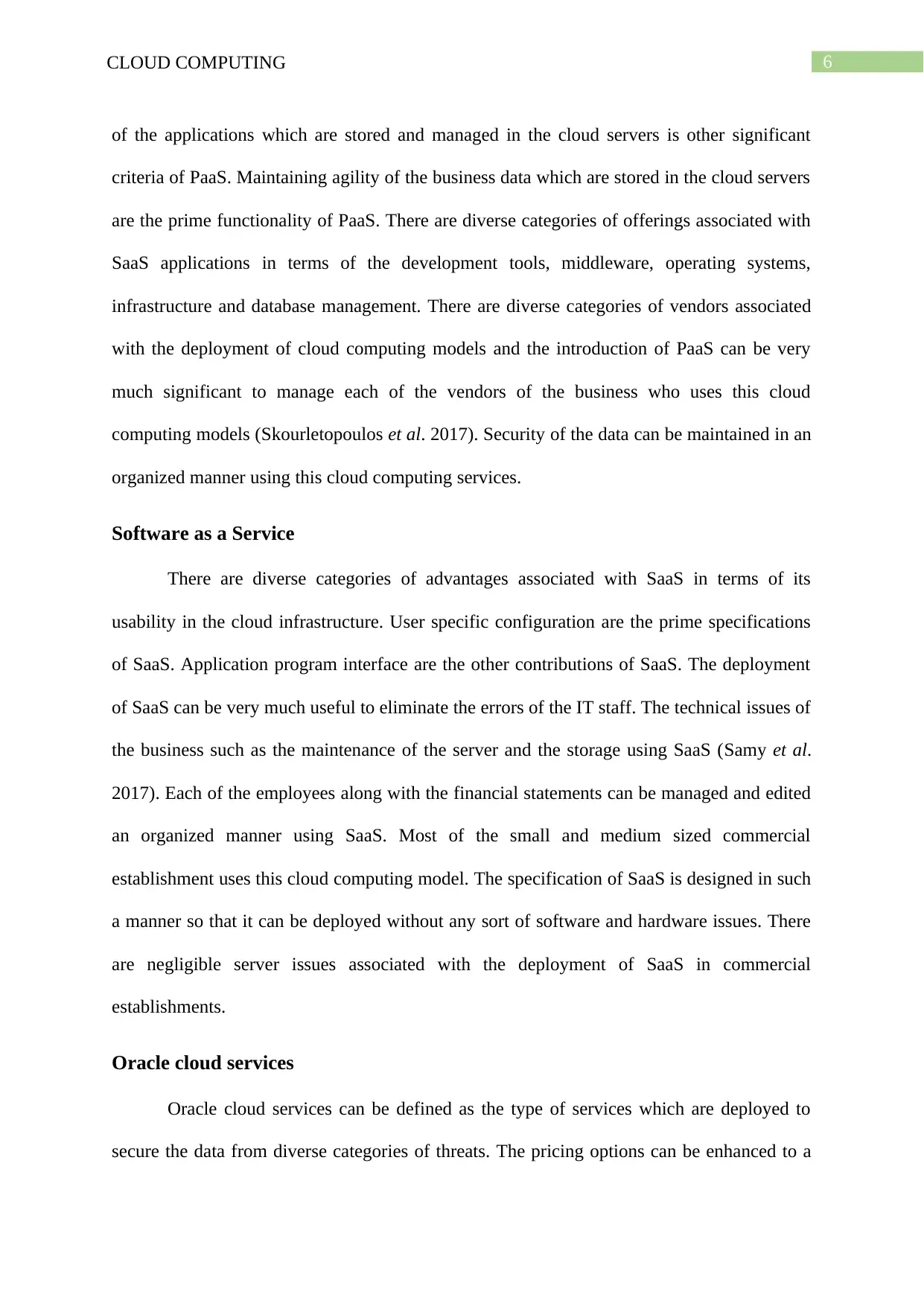
6CLOUD COMPUTING
of the applications which are stored and managed in the cloud servers is other significant
criteria of PaaS. Maintaining agility of the business data which are stored in the cloud servers
are the prime functionality of PaaS. There are diverse categories of offerings associated with
SaaS applications in terms of the development tools, middleware, operating systems,
infrastructure and database management. There are diverse categories of vendors associated
with the deployment of cloud computing models and the introduction of PaaS can be very
much significant to manage each of the vendors of the business who uses this cloud
computing models (Skourletopoulos et al. 2017). Security of the data can be maintained in an
organized manner using this cloud computing services.
Software as a Service
There are diverse categories of advantages associated with SaaS in terms of its
usability in the cloud infrastructure. User specific configuration are the prime specifications
of SaaS. Application program interface are the other contributions of SaaS. The deployment
of SaaS can be very much useful to eliminate the errors of the IT staff. The technical issues of
the business such as the maintenance of the server and the storage using SaaS (Samy et al.
2017). Each of the employees along with the financial statements can be managed and edited
an organized manner using SaaS. Most of the small and medium sized commercial
establishment uses this cloud computing model. The specification of SaaS is designed in such
a manner so that it can be deployed without any sort of software and hardware issues. There
are negligible server issues associated with the deployment of SaaS in commercial
establishments.
Oracle cloud services
Oracle cloud services can be defined as the type of services which are deployed to
secure the data from diverse categories of threats. The pricing options can be enhanced to a
of the applications which are stored and managed in the cloud servers is other significant
criteria of PaaS. Maintaining agility of the business data which are stored in the cloud servers
are the prime functionality of PaaS. There are diverse categories of offerings associated with
SaaS applications in terms of the development tools, middleware, operating systems,
infrastructure and database management. There are diverse categories of vendors associated
with the deployment of cloud computing models and the introduction of PaaS can be very
much significant to manage each of the vendors of the business who uses this cloud
computing models (Skourletopoulos et al. 2017). Security of the data can be maintained in an
organized manner using this cloud computing services.
Software as a Service
There are diverse categories of advantages associated with SaaS in terms of its
usability in the cloud infrastructure. User specific configuration are the prime specifications
of SaaS. Application program interface are the other contributions of SaaS. The deployment
of SaaS can be very much useful to eliminate the errors of the IT staff. The technical issues of
the business such as the maintenance of the server and the storage using SaaS (Samy et al.
2017). Each of the employees along with the financial statements can be managed and edited
an organized manner using SaaS. Most of the small and medium sized commercial
establishment uses this cloud computing model. The specification of SaaS is designed in such
a manner so that it can be deployed without any sort of software and hardware issues. There
are negligible server issues associated with the deployment of SaaS in commercial
establishments.
Oracle cloud services
Oracle cloud services can be defined as the type of services which are deployed to
secure the data from diverse categories of threats. The pricing options can be enhanced to a
Paraphrase This Document
Need a fresh take? Get an instant paraphrase of this document with our AI Paraphraser
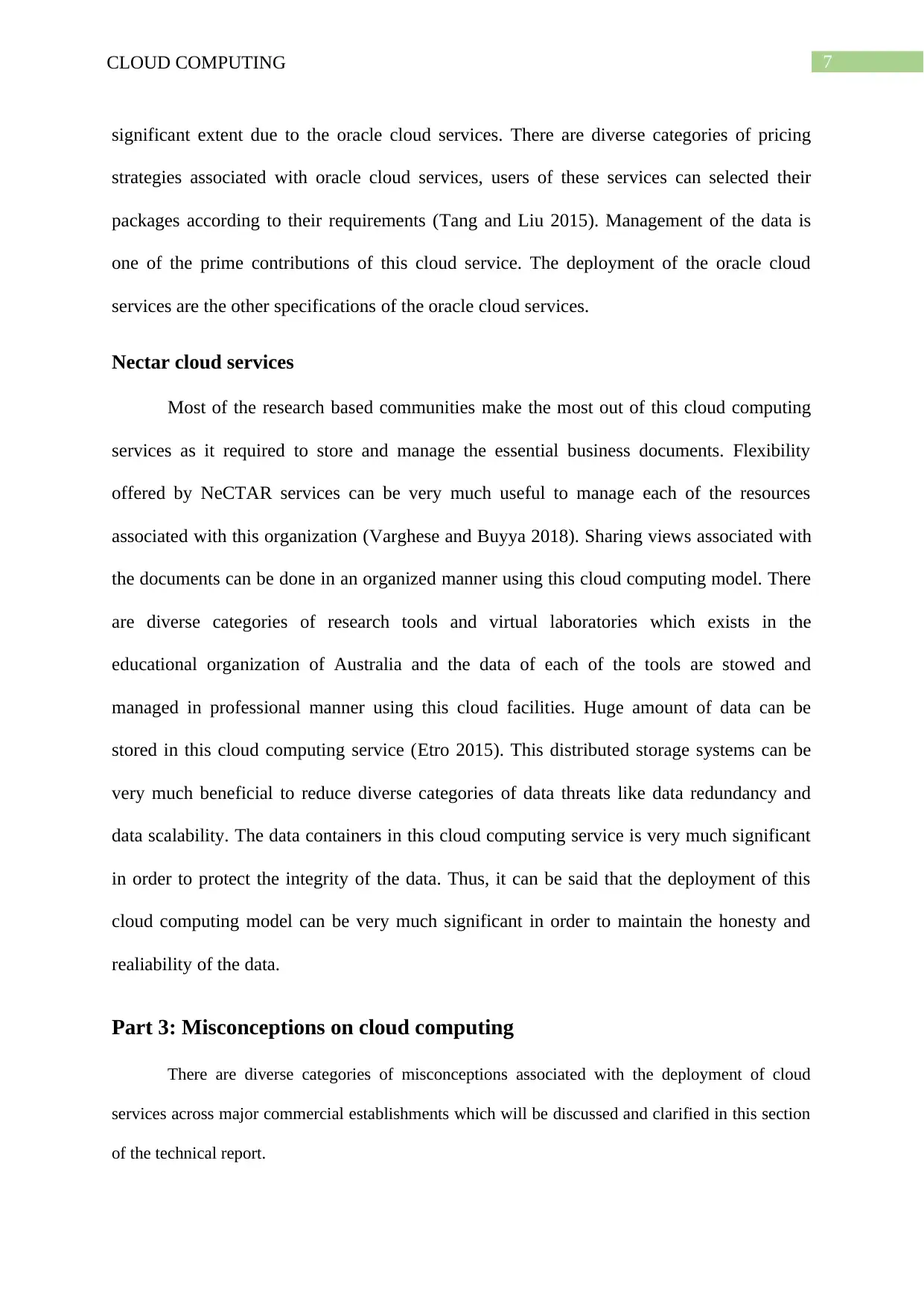
7CLOUD COMPUTING
significant extent due to the oracle cloud services. There are diverse categories of pricing
strategies associated with oracle cloud services, users of these services can selected their
packages according to their requirements (Tang and Liu 2015). Management of the data is
one of the prime contributions of this cloud service. The deployment of the oracle cloud
services are the other specifications of the oracle cloud services.
Nectar cloud services
Most of the research based communities make the most out of this cloud computing
services as it required to store and manage the essential business documents. Flexibility
offered by NeCTAR services can be very much useful to manage each of the resources
associated with this organization (Varghese and Buyya 2018). Sharing views associated with
the documents can be done in an organized manner using this cloud computing model. There
are diverse categories of research tools and virtual laboratories which exists in the
educational organization of Australia and the data of each of the tools are stowed and
managed in professional manner using this cloud facilities. Huge amount of data can be
stored in this cloud computing service (Etro 2015). This distributed storage systems can be
very much beneficial to reduce diverse categories of data threats like data redundancy and
data scalability. The data containers in this cloud computing service is very much significant
in order to protect the integrity of the data. Thus, it can be said that the deployment of this
cloud computing model can be very much significant in order to maintain the honesty and
realiability of the data.
Part 3: Misconceptions on cloud computing
There are diverse categories of misconceptions associated with the deployment of cloud
services across major commercial establishments which will be discussed and clarified in this section
of the technical report.
significant extent due to the oracle cloud services. There are diverse categories of pricing
strategies associated with oracle cloud services, users of these services can selected their
packages according to their requirements (Tang and Liu 2015). Management of the data is
one of the prime contributions of this cloud service. The deployment of the oracle cloud
services are the other specifications of the oracle cloud services.
Nectar cloud services
Most of the research based communities make the most out of this cloud computing
services as it required to store and manage the essential business documents. Flexibility
offered by NeCTAR services can be very much useful to manage each of the resources
associated with this organization (Varghese and Buyya 2018). Sharing views associated with
the documents can be done in an organized manner using this cloud computing model. There
are diverse categories of research tools and virtual laboratories which exists in the
educational organization of Australia and the data of each of the tools are stowed and
managed in professional manner using this cloud facilities. Huge amount of data can be
stored in this cloud computing service (Etro 2015). This distributed storage systems can be
very much beneficial to reduce diverse categories of data threats like data redundancy and
data scalability. The data containers in this cloud computing service is very much significant
in order to protect the integrity of the data. Thus, it can be said that the deployment of this
cloud computing model can be very much significant in order to maintain the honesty and
realiability of the data.
Part 3: Misconceptions on cloud computing
There are diverse categories of misconceptions associated with the deployment of cloud
services across major commercial establishments which will be discussed and clarified in this section
of the technical report.
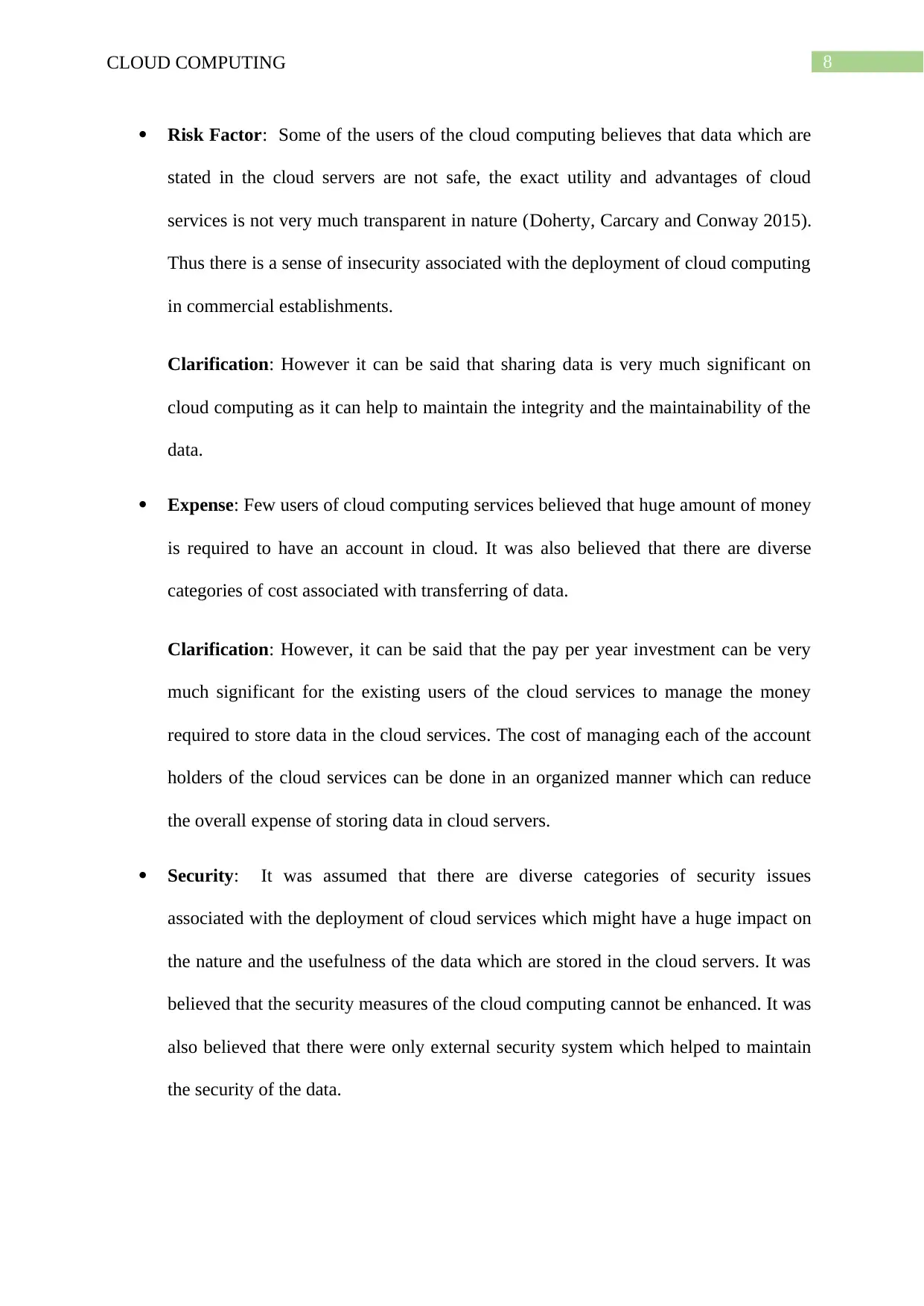
8CLOUD COMPUTING
Risk Factor: Some of the users of the cloud computing believes that data which are
stated in the cloud servers are not safe, the exact utility and advantages of cloud
services is not very much transparent in nature (Doherty, Carcary and Conway 2015).
Thus there is a sense of insecurity associated with the deployment of cloud computing
in commercial establishments.
Clarification: However it can be said that sharing data is very much significant on
cloud computing as it can help to maintain the integrity and the maintainability of the
data.
Expense: Few users of cloud computing services believed that huge amount of money
is required to have an account in cloud. It was also believed that there are diverse
categories of cost associated with transferring of data.
Clarification: However, it can be said that the pay per year investment can be very
much significant for the existing users of the cloud services to manage the money
required to store data in the cloud services. The cost of managing each of the account
holders of the cloud services can be done in an organized manner which can reduce
the overall expense of storing data in cloud servers.
Security: It was assumed that there are diverse categories of security issues
associated with the deployment of cloud services which might have a huge impact on
the nature and the usefulness of the data which are stored in the cloud servers. It was
believed that the security measures of the cloud computing cannot be enhanced. It was
also believed that there were only external security system which helped to maintain
the security of the data.
Risk Factor: Some of the users of the cloud computing believes that data which are
stated in the cloud servers are not safe, the exact utility and advantages of cloud
services is not very much transparent in nature (Doherty, Carcary and Conway 2015).
Thus there is a sense of insecurity associated with the deployment of cloud computing
in commercial establishments.
Clarification: However it can be said that sharing data is very much significant on
cloud computing as it can help to maintain the integrity and the maintainability of the
data.
Expense: Few users of cloud computing services believed that huge amount of money
is required to have an account in cloud. It was also believed that there are diverse
categories of cost associated with transferring of data.
Clarification: However, it can be said that the pay per year investment can be very
much significant for the existing users of the cloud services to manage the money
required to store data in the cloud services. The cost of managing each of the account
holders of the cloud services can be done in an organized manner which can reduce
the overall expense of storing data in cloud servers.
Security: It was assumed that there are diverse categories of security issues
associated with the deployment of cloud services which might have a huge impact on
the nature and the usefulness of the data which are stored in the cloud servers. It was
believed that the security measures of the cloud computing cannot be enhanced. It was
also believed that there were only external security system which helped to maintain
the security of the data.
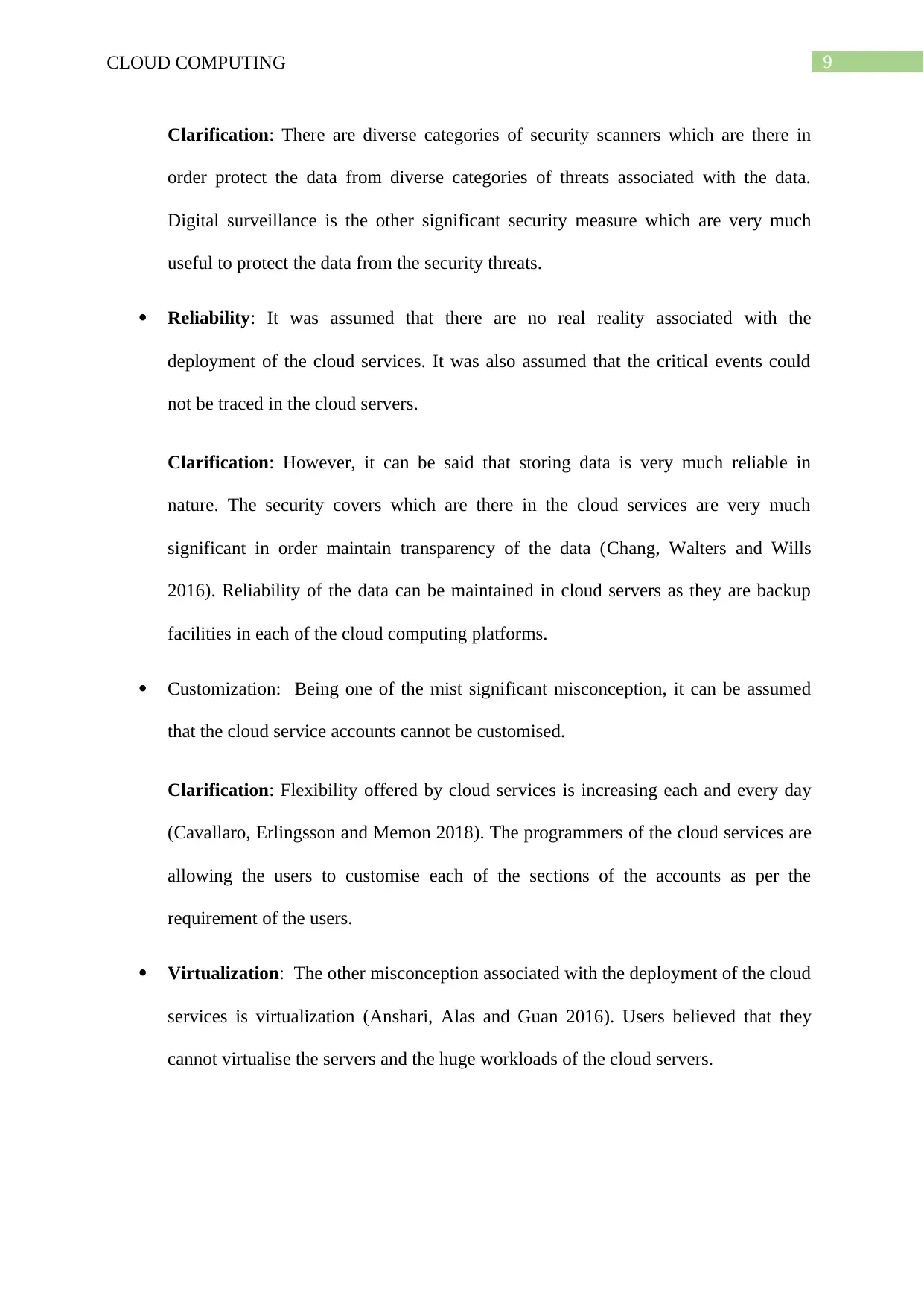
9CLOUD COMPUTING
Clarification: There are diverse categories of security scanners which are there in
order protect the data from diverse categories of threats associated with the data.
Digital surveillance is the other significant security measure which are very much
useful to protect the data from the security threats.
Reliability: It was assumed that there are no real reality associated with the
deployment of the cloud services. It was also assumed that the critical events could
not be traced in the cloud servers.
Clarification: However, it can be said that storing data is very much reliable in
nature. The security covers which are there in the cloud services are very much
significant in order maintain transparency of the data (Chang, Walters and Wills
2016). Reliability of the data can be maintained in cloud servers as they are backup
facilities in each of the cloud computing platforms.
Customization: Being one of the mist significant misconception, it can be assumed
that the cloud service accounts cannot be customised.
Clarification: Flexibility offered by cloud services is increasing each and every day
(Cavallaro, Erlingsson and Memon 2018). The programmers of the cloud services are
allowing the users to customise each of the sections of the accounts as per the
requirement of the users.
Virtualization: The other misconception associated with the deployment of the cloud
services is virtualization (Anshari, Alas and Guan 2016). Users believed that they
cannot virtualise the servers and the huge workloads of the cloud servers.
Clarification: There are diverse categories of security scanners which are there in
order protect the data from diverse categories of threats associated with the data.
Digital surveillance is the other significant security measure which are very much
useful to protect the data from the security threats.
Reliability: It was assumed that there are no real reality associated with the
deployment of the cloud services. It was also assumed that the critical events could
not be traced in the cloud servers.
Clarification: However, it can be said that storing data is very much reliable in
nature. The security covers which are there in the cloud services are very much
significant in order maintain transparency of the data (Chang, Walters and Wills
2016). Reliability of the data can be maintained in cloud servers as they are backup
facilities in each of the cloud computing platforms.
Customization: Being one of the mist significant misconception, it can be assumed
that the cloud service accounts cannot be customised.
Clarification: Flexibility offered by cloud services is increasing each and every day
(Cavallaro, Erlingsson and Memon 2018). The programmers of the cloud services are
allowing the users to customise each of the sections of the accounts as per the
requirement of the users.
Virtualization: The other misconception associated with the deployment of the cloud
services is virtualization (Anshari, Alas and Guan 2016). Users believed that they
cannot virtualise the servers and the huge workloads of the cloud servers.
Secure Best Marks with AI Grader
Need help grading? Try our AI Grader for instant feedback on your assignments.
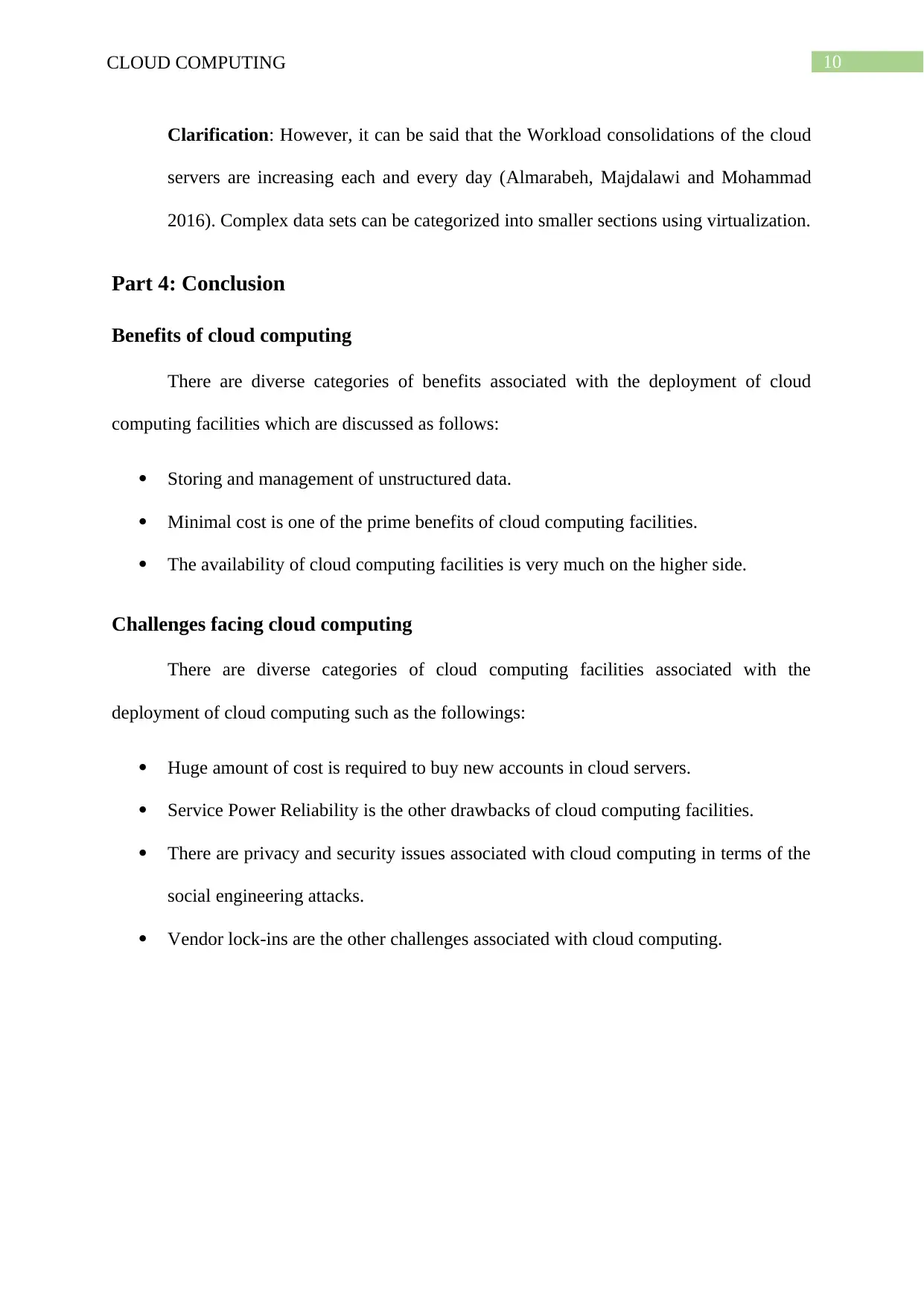
10CLOUD COMPUTING
Clarification: However, it can be said that the Workload consolidations of the cloud
servers are increasing each and every day (Almarabeh, Majdalawi and Mohammad
2016). Complex data sets can be categorized into smaller sections using virtualization.
Part 4: Conclusion
Benefits of cloud computing
There are diverse categories of benefits associated with the deployment of cloud
computing facilities which are discussed as follows:
Storing and management of unstructured data.
Minimal cost is one of the prime benefits of cloud computing facilities.
The availability of cloud computing facilities is very much on the higher side.
Challenges facing cloud computing
There are diverse categories of cloud computing facilities associated with the
deployment of cloud computing such as the followings:
Huge amount of cost is required to buy new accounts in cloud servers.
Service Power Reliability is the other drawbacks of cloud computing facilities.
There are privacy and security issues associated with cloud computing in terms of the
social engineering attacks.
Vendor lock-ins are the other challenges associated with cloud computing.
Clarification: However, it can be said that the Workload consolidations of the cloud
servers are increasing each and every day (Almarabeh, Majdalawi and Mohammad
2016). Complex data sets can be categorized into smaller sections using virtualization.
Part 4: Conclusion
Benefits of cloud computing
There are diverse categories of benefits associated with the deployment of cloud
computing facilities which are discussed as follows:
Storing and management of unstructured data.
Minimal cost is one of the prime benefits of cloud computing facilities.
The availability of cloud computing facilities is very much on the higher side.
Challenges facing cloud computing
There are diverse categories of cloud computing facilities associated with the
deployment of cloud computing such as the followings:
Huge amount of cost is required to buy new accounts in cloud servers.
Service Power Reliability is the other drawbacks of cloud computing facilities.
There are privacy and security issues associated with cloud computing in terms of the
social engineering attacks.
Vendor lock-ins are the other challenges associated with cloud computing.
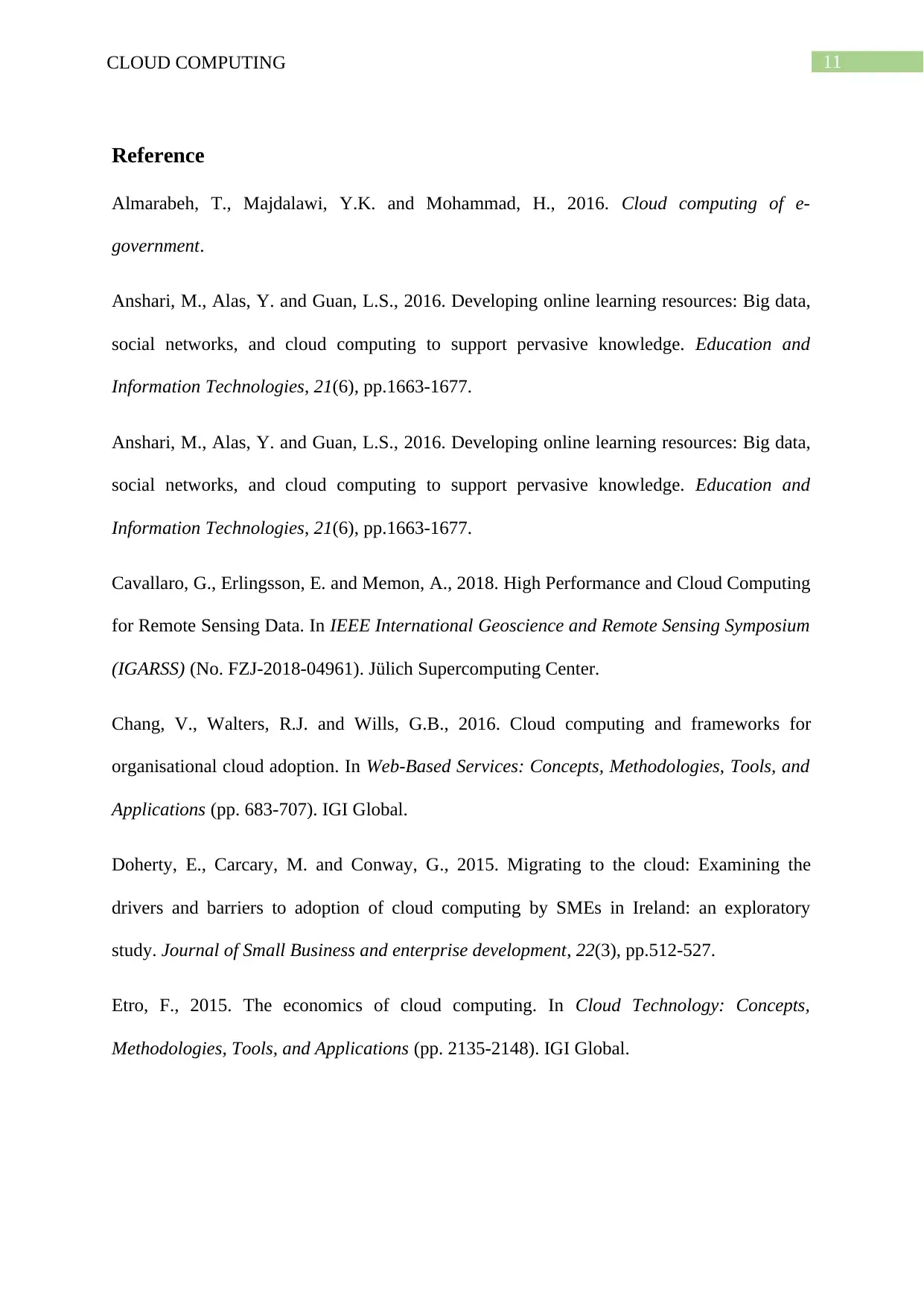
11CLOUD COMPUTING
Reference
Almarabeh, T., Majdalawi, Y.K. and Mohammad, H., 2016. Cloud computing of e-
government.
Anshari, M., Alas, Y. and Guan, L.S., 2016. Developing online learning resources: Big data,
social networks, and cloud computing to support pervasive knowledge. Education and
Information Technologies, 21(6), pp.1663-1677.
Anshari, M., Alas, Y. and Guan, L.S., 2016. Developing online learning resources: Big data,
social networks, and cloud computing to support pervasive knowledge. Education and
Information Technologies, 21(6), pp.1663-1677.
Cavallaro, G., Erlingsson, E. and Memon, A., 2018. High Performance and Cloud Computing
for Remote Sensing Data. In IEEE International Geoscience and Remote Sensing Symposium
(IGARSS) (No. FZJ-2018-04961). Jülich Supercomputing Center.
Chang, V., Walters, R.J. and Wills, G.B., 2016. Cloud computing and frameworks for
organisational cloud adoption. In Web-Based Services: Concepts, Methodologies, Tools, and
Applications (pp. 683-707). IGI Global.
Doherty, E., Carcary, M. and Conway, G., 2015. Migrating to the cloud: Examining the
drivers and barriers to adoption of cloud computing by SMEs in Ireland: an exploratory
study. Journal of Small Business and enterprise development, 22(3), pp.512-527.
Etro, F., 2015. The economics of cloud computing. In Cloud Technology: Concepts,
Methodologies, Tools, and Applications (pp. 2135-2148). IGI Global.
Reference
Almarabeh, T., Majdalawi, Y.K. and Mohammad, H., 2016. Cloud computing of e-
government.
Anshari, M., Alas, Y. and Guan, L.S., 2016. Developing online learning resources: Big data,
social networks, and cloud computing to support pervasive knowledge. Education and
Information Technologies, 21(6), pp.1663-1677.
Anshari, M., Alas, Y. and Guan, L.S., 2016. Developing online learning resources: Big data,
social networks, and cloud computing to support pervasive knowledge. Education and
Information Technologies, 21(6), pp.1663-1677.
Cavallaro, G., Erlingsson, E. and Memon, A., 2018. High Performance and Cloud Computing
for Remote Sensing Data. In IEEE International Geoscience and Remote Sensing Symposium
(IGARSS) (No. FZJ-2018-04961). Jülich Supercomputing Center.
Chang, V., Walters, R.J. and Wills, G.B., 2016. Cloud computing and frameworks for
organisational cloud adoption. In Web-Based Services: Concepts, Methodologies, Tools, and
Applications (pp. 683-707). IGI Global.
Doherty, E., Carcary, M. and Conway, G., 2015. Migrating to the cloud: Examining the
drivers and barriers to adoption of cloud computing by SMEs in Ireland: an exploratory
study. Journal of Small Business and enterprise development, 22(3), pp.512-527.
Etro, F., 2015. The economics of cloud computing. In Cloud Technology: Concepts,
Methodologies, Tools, and Applications (pp. 2135-2148). IGI Global.
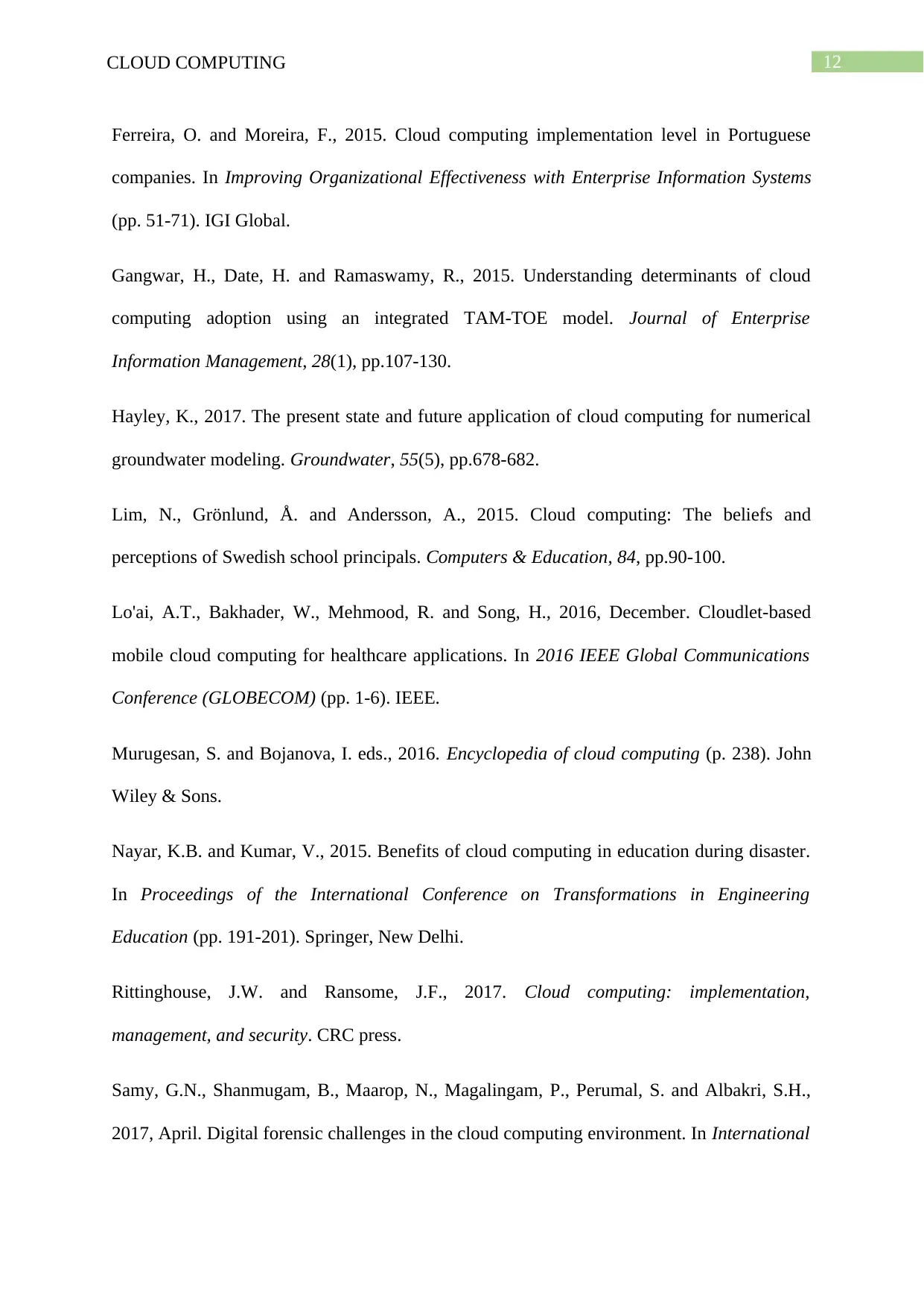
12CLOUD COMPUTING
Ferreira, O. and Moreira, F., 2015. Cloud computing implementation level in Portuguese
companies. In Improving Organizational Effectiveness with Enterprise Information Systems
(pp. 51-71). IGI Global.
Gangwar, H., Date, H. and Ramaswamy, R., 2015. Understanding determinants of cloud
computing adoption using an integrated TAM-TOE model. Journal of Enterprise
Information Management, 28(1), pp.107-130.
Hayley, K., 2017. The present state and future application of cloud computing for numerical
groundwater modeling. Groundwater, 55(5), pp.678-682.
Lim, N., Grönlund, Å. and Andersson, A., 2015. Cloud computing: The beliefs and
perceptions of Swedish school principals. Computers & Education, 84, pp.90-100.
Lo'ai, A.T., Bakhader, W., Mehmood, R. and Song, H., 2016, December. Cloudlet-based
mobile cloud computing for healthcare applications. In 2016 IEEE Global Communications
Conference (GLOBECOM) (pp. 1-6). IEEE.
Murugesan, S. and Bojanova, I. eds., 2016. Encyclopedia of cloud computing (p. 238). John
Wiley & Sons.
Nayar, K.B. and Kumar, V., 2015. Benefits of cloud computing in education during disaster.
In Proceedings of the International Conference on Transformations in Engineering
Education (pp. 191-201). Springer, New Delhi.
Rittinghouse, J.W. and Ransome, J.F., 2017. Cloud computing: implementation,
management, and security. CRC press.
Samy, G.N., Shanmugam, B., Maarop, N., Magalingam, P., Perumal, S. and Albakri, S.H.,
2017, April. Digital forensic challenges in the cloud computing environment. In International
Ferreira, O. and Moreira, F., 2015. Cloud computing implementation level in Portuguese
companies. In Improving Organizational Effectiveness with Enterprise Information Systems
(pp. 51-71). IGI Global.
Gangwar, H., Date, H. and Ramaswamy, R., 2015. Understanding determinants of cloud
computing adoption using an integrated TAM-TOE model. Journal of Enterprise
Information Management, 28(1), pp.107-130.
Hayley, K., 2017. The present state and future application of cloud computing for numerical
groundwater modeling. Groundwater, 55(5), pp.678-682.
Lim, N., Grönlund, Å. and Andersson, A., 2015. Cloud computing: The beliefs and
perceptions of Swedish school principals. Computers & Education, 84, pp.90-100.
Lo'ai, A.T., Bakhader, W., Mehmood, R. and Song, H., 2016, December. Cloudlet-based
mobile cloud computing for healthcare applications. In 2016 IEEE Global Communications
Conference (GLOBECOM) (pp. 1-6). IEEE.
Murugesan, S. and Bojanova, I. eds., 2016. Encyclopedia of cloud computing (p. 238). John
Wiley & Sons.
Nayar, K.B. and Kumar, V., 2015. Benefits of cloud computing in education during disaster.
In Proceedings of the International Conference on Transformations in Engineering
Education (pp. 191-201). Springer, New Delhi.
Rittinghouse, J.W. and Ransome, J.F., 2017. Cloud computing: implementation,
management, and security. CRC press.
Samy, G.N., Shanmugam, B., Maarop, N., Magalingam, P., Perumal, S. and Albakri, S.H.,
2017, April. Digital forensic challenges in the cloud computing environment. In International
Paraphrase This Document
Need a fresh take? Get an instant paraphrase of this document with our AI Paraphraser
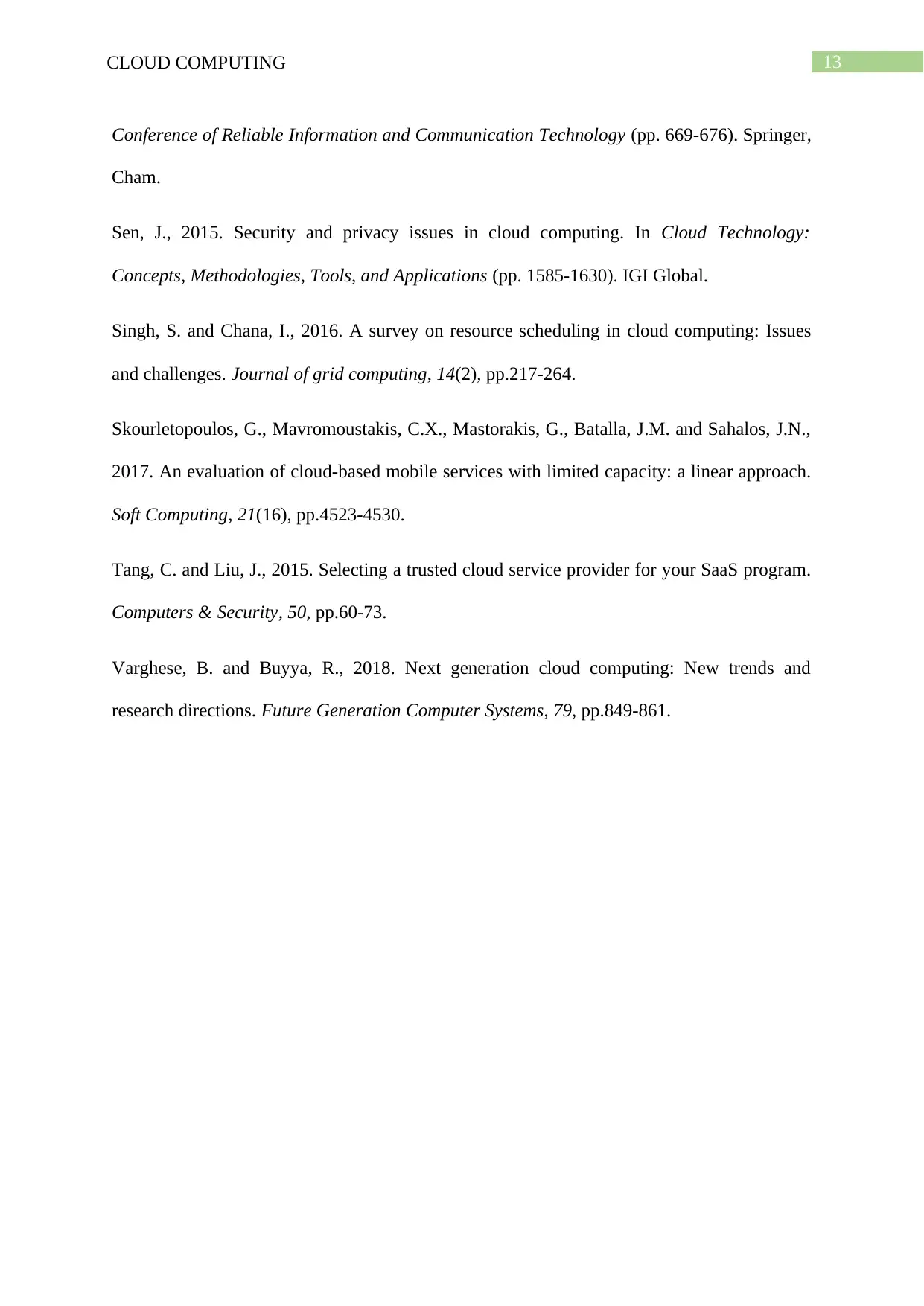
13CLOUD COMPUTING
Conference of Reliable Information and Communication Technology (pp. 669-676). Springer,
Cham.
Sen, J., 2015. Security and privacy issues in cloud computing. In Cloud Technology:
Concepts, Methodologies, Tools, and Applications (pp. 1585-1630). IGI Global.
Singh, S. and Chana, I., 2016. A survey on resource scheduling in cloud computing: Issues
and challenges. Journal of grid computing, 14(2), pp.217-264.
Skourletopoulos, G., Mavromoustakis, C.X., Mastorakis, G., Batalla, J.M. and Sahalos, J.N.,
2017. An evaluation of cloud-based mobile services with limited capacity: a linear approach.
Soft Computing, 21(16), pp.4523-4530.
Tang, C. and Liu, J., 2015. Selecting a trusted cloud service provider for your SaaS program.
Computers & Security, 50, pp.60-73.
Varghese, B. and Buyya, R., 2018. Next generation cloud computing: New trends and
research directions. Future Generation Computer Systems, 79, pp.849-861.
Conference of Reliable Information and Communication Technology (pp. 669-676). Springer,
Cham.
Sen, J., 2015. Security and privacy issues in cloud computing. In Cloud Technology:
Concepts, Methodologies, Tools, and Applications (pp. 1585-1630). IGI Global.
Singh, S. and Chana, I., 2016. A survey on resource scheduling in cloud computing: Issues
and challenges. Journal of grid computing, 14(2), pp.217-264.
Skourletopoulos, G., Mavromoustakis, C.X., Mastorakis, G., Batalla, J.M. and Sahalos, J.N.,
2017. An evaluation of cloud-based mobile services with limited capacity: a linear approach.
Soft Computing, 21(16), pp.4523-4530.
Tang, C. and Liu, J., 2015. Selecting a trusted cloud service provider for your SaaS program.
Computers & Security, 50, pp.60-73.
Varghese, B. and Buyya, R., 2018. Next generation cloud computing: New trends and
research directions. Future Generation Computer Systems, 79, pp.849-861.
1 out of 14
Related Documents
Your All-in-One AI-Powered Toolkit for Academic Success.
+13062052269
info@desklib.com
Available 24*7 on WhatsApp / Email
![[object Object]](/_next/static/media/star-bottom.7253800d.svg)
Unlock your academic potential
© 2024 | Zucol Services PVT LTD | All rights reserved.





